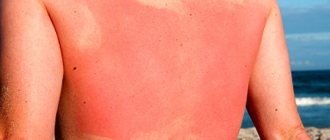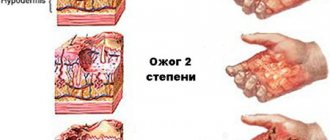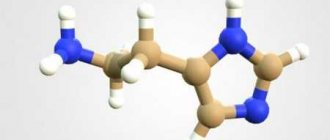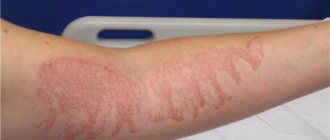Most often, victims get by with the mildest degree of damage.
Steam burns often occur in everyday life. It is obtained by careless handling of a kettle or boiling water in pans. Most often, victims get by with the mildest degree of damage, in which there is no great redness and the cells heal quickly. But sometimes scalded areas that have been scalded with steam may not heal for a long time. It is important to know how to properly provide assistance and what effective means can be used in complex therapy.
4th degree
Fourth degree steam burns can cause deep and serious damage such as charring of the skin. Treatment of the consequences takes place only in a hospital setting and under the strict supervision of specialists. This degree of burn is characterized by a long healing process.
It is easy to understand that the most dangerous are third and fourth degree burns from steam. If the patient has more than 10% of the area damaged, then urgent hospitalization of the person is necessary, and, as a rule, to specialized departments for the treatment of steam burns. What to do at home? More on this later.
Most often, steam burns are first and second degree. In such cases, providing immediate first aid at home is not difficult. Third- and fourth-degree steam burns typically occur during large-scale industrial accidents or work-related injuries.
Most often, people burn their hands at home with hot boiling water or boiling liquid used in the household.
In what cases should you contact specialists?
For large areas of skin burns, after the ambulance arrives, the victim is admitted to the hospital for further treatment. In the case of deep burns of a large area of the body, observation by more serious specialists may be necessary; restoring the integrity of the skin is only possible through surgery. You should seek medical help in the following cases:
- burn of the palate and mucous membranes (eyes, nose, respiratory tract);
- the presence of previously existing open wounds;
- lesions of the face and groin area;
- deterioration of health (high temperature, weakness).
It is recommended to go to the hospital if a blister, which appears with a 2nd degree burn, has burst. The doctor will clean the wound to avoid infection. You should also see a specialist if the skin has peeled off and the wound has started to get wet. In this situation, a course of infrared lamp is prescribed.
It is necessary to consult a doctor as soon as possible if a small child (under 7 years old) or an elderly person has been burned by steam. In these categories, regeneration processes occur in a special way. If you try to provide independent assistance, you can harm the victim.
During household contacts with vapors, caution and safety measures should be taken - avoid direct interaction, do not allow the vapor to come into contact with the face. Burns from hot steam can have serious consequences. It is necessary to be able to help the victim independently; in case of serious damage to the mucous membrane, saving one’s health can take minutes.
The article has been verified by the editors
First aid for steam burns
The procedure for providing first aid for a steam burn is as follows:
- First, you need to free the damaged area from excess clothing, jewelry, watches, etc. If necessary, you should use scissors so as not to cause even more damage to the damaged skin.
- Then it is urgently necessary to cool the damaged area of skin. As a rule, 10-20 minutes under a stream of cold running water directed at the scalded area is sufficient. If suddenly there is no source of water nearby, then you should use ice or other very cold objects. But you should not forget that excessive use of ice can harm the victim by necrosis of epidermal cells, so this cooling process should not last longer than 5-10 minutes. What to do at home in case of a steam burn is of interest to many.
- As with other types of thermal burns, the injury gives a person very burning, acute pain. This is because after contact with high temperatures, the skin continues to heat up for some time. Therefore, it is very important to cool the wound with cold temperatures in a timely manner, as this will stop damage to the epidermal tissue and relieve pain. Due to the effects of cold, the temperature of the damaged area will decrease, which will reduce the spread of thermal damage.
- After the pain is relieved, it is necessary to treat the wound with anti-inflammatory drugs. For example, potassium permanganate (potassium permanganate) is very often used as an antiseptic for disinfecting burn wounds. To prepare the solution, dilute 1 g of the product in 150 g of water and mix thoroughly. The resulting solution must be filtered through gauze, because if manganese crystals get on the wound, the burn may increase. The instructions for using potassium permanganate state its purpose for treating burn wounds, ulcers, etc. If you doubt and are afraid to use this remedy, then it is better to skip this step.
- Next, it is very important to apply a bandage. After the wound is treated, a bandage must be applied to the injury site using a sterile and as clean bandage as possible. It is necessary to use fabric that is highly breathable, preferably of a natural composition.
- The burn must first be treated with a healing ointment for burns (Olazol spray, for example), various anti-burn agents and gels. It is necessary to apply them to the damaged area of the skin, leave it for some time, and then apply a bandage, which serves as a kind of protection for the wound from infections that are nearby. Everyone should have anti-burn medications in their home medicine cabinet.
We will consider traditional methods of treating burns below.
Remember that burns should not be lubricated with oil or regular cream. These agents prevent heat from escaping, creating a barrier, which means the duration of wound healing and pain relief will increase. If blisters form as a result of a burn, then under no circumstances should their integrity be damaged, otherwise an infection may enter the wound.
Signs and symptoms
Burn injuries vary in severity, which is expressed in 4 degrees with inherent symptoms:
- Skin redness, itching and swelling. Painful sensations are tolerable. Symptoms disappear within 3-4 days.
- The formation of blisters (vesicles containing serous fluid), which can burst and cause severe pain. Recovery occurs in 10-15 days.
- Cell death, dark crust covering. All skin layers are affected; it is possible to restore the original integrity with cosmetic and drug treatment. In some cases, operations are prescribed.
- It is characterized by deep damage affecting tendons, muscles, and bones. There is a risk of death.
The scale of the resulting lesions is assessed with the hand - an open palm is equivalent to 1% of the human body. Often, thermal exposure causes accompanying symptoms – fever, weakness, pain shock.
Why is a steam burn more dangerous than a boiling water burn?
- The boiling points of the liquid and the vapor formed from it are different. The temperature of steam can be much higher than water, especially under pressure. That is why a burn from steam is much heavier and stronger, and therefore more dangerous.
- If a hot liquid gets on a person’s body, it cools quickly enough to a temperature of 36.6°C. When steam changes from a gaseous state to a liquid state, condensation is created, which releases even more heat. This is another reason for the danger of steam burns.
Classification
As the water heats up, steam appears. Its temperature, especially if it is formed under pressure, is above 100 ℃. Once on the skin, the steam transfers its heat to it and causes serious damage .
There is a special classification of steam burns according to severity:
- The first degree is diagnosed when redness and slight swelling of the surface layer of the epidermis are detected. The affected area hurts and looks inflamed.
- The second degree is characterized by the appearance of blisters filled with yellowish liquid. The surrounding skin turns bright pink and swells.
- The third degree is necrosis of the upper layers of the epidermis. Long-healing wounds and blisters with blood form on the body.
- The fourth - causes necrosis of the middle layer and can affect the fat layer, muscles and bones.
The severity of the condition depends on the area of the lesion. 1st and 2nd degree burns, if less than 5% of the skin is injured, do not require hospitalization. Grade 3 and 4 hot steam wounds require professional therapy in a medical facility.
Folk recipes
Along with pharmaceutical anti-burn drugs, there are a large number of folk recipes and tips for combating injury. Despite the development of the modern industry, the popularity of folk remedies does not decrease, because their great advantage is that everything you need is within walking distance. Let's list some effective folk remedies:
- The foam created by over-beating egg whites is great for applying to a burn.
- Grated raw potatoes and carrots also effectively help with burns. You can add honey to the resulting mass to enhance the effect: 1 teaspoon per 100 g of mass. The resulting mixture is applied to the damaged area of skin.
- You can also lubricate the burn area with aloe juice, released when a plant leaf is cut. Or grind it into a paste and apply it to the wound.
- You can soften a plantain or cabbage leaf and apply it to the damaged area of skin for ten minutes.
- Mix 100 g butter, 20 g linseed oil, 100 g melted natural beeswax. Heat this mixture in a water bath for five minutes and then cool, stirring slowly. A slightly warm ointment should be applied to a gauze bandage and cover the burned area of skin with it. The bandage needs to be changed twice a day.
Possible consequences
Treatment must begin immediately: steam burns often cause complications. These include:
- Infection of the affected area, often bacterial. Typically, those at risk are children, the elderly, and those who have chronic diseases: diabetes mellitus, impaired functioning of the kidneys, liver, and pancreas. Pain and itching can become companions for months, and the burned area will be especially sensitive to the sun's rays.
- Dehydration of the body in case of extensive burns. The consequence is kidney failure.
- Tissue necrosis due to incorrect (independent) treatment.
- Scars that require surgery to remove.
Pharmaceuticals
Among the anti-burn agents produced by pharmaceutical manufacturers, the following are the most effective and popular:
- “Panthenol” - the main component is dexpanthenol, which can quickly restore the structure of the skin and heal wounds. Instructions for use for “Panthenol spray” for burns are included in each package.
- "Bepanten-plus" - helps not only to quickly regenerate skin cells, but also to disinfect the site of damage.
- Spray "Olazol" - contains levomecetin, anesthesin and sea buckthorn oil.
- "Radevit."
If you receive a burn from steam, you should contact a specialist for help. This type of injury should not be underestimated.
We looked at what to do at home for steam burns.
What not to do
Wrong actions can lead to complications and aggravate the situation . To avoid unpleasant consequences, you must remember about unwanted and prohibited manipulations when providing assistance to the victim:
- tearing off stuck clothes;
- use of non-sterile products;
- puncturing blisters;
- use of drugs for other purposes;
- applying oils, fatty creams, fermented milk products;
- surface disinfection with alcohol-containing solutions (iodine, brilliant green).
Treatment
After providing first aid for a steam burn at home, the doctor selects treatment. To heal a burn, medications are used that accelerate regeneration processes, reduce pain and prevent inflammatory processes. At the same time, folk remedies can be used, but only in agreement with the attending physician.
Folk recipes
Traditional medicine can be effective in treating early stage burns. They should not be used for deep skin lesions. To recover from injury, use the following recipes:
The potatoes are grated and applied to the affected area.
- Grate raw potatoes. The root vegetable is placed in a clean cloth (for example, a bandage) and applied to the affected area. Change the bandage every couple of hours;
- A decoction of oak bark has anti-inflammatory properties. To do this, you need to purchase the crushed product at the pharmacy, brew it with boiling water and let it brew. Compresses made from cloth soaked in the broth are applied to the affected area;
- aloe juice can also be used in the form of compresses, or you can treat the area of skin that has come into contact with the steam;
- honey compresses are used to eliminate inflammatory processes and accelerate the regeneration of burned surfaces.
Pharmaceuticals
Steam burns are treated using medications prescribed by the attending physician. The wound is treated with antiseptic solutions to prevent infections. In severe cases of lesions, antibiotics are prescribed. Healing ointments accelerate regeneration and relieve pain in damaged areas:
- Panthenol is available in the form of an ointment and a spray. The main active ingredient is dexpanthenol. The product relieves pain, eliminates swelling, reduces itching and speeds up recovery;
- Bepanthen also contains dexpanthenol. Has the same properties;
- Olazol spray is easy to apply. Contains an antibiotic, so it effectively fights infection and heals affected areas.
If the skin is slightly damaged when exposed to steam, you can help the victim at home. In case of severe damage or injury to the mucous membranes, it is necessary to hospitalize the person in a medical facility.
httpv://www.youtube.com/watch?v=embed/3AAknC3MNMg











